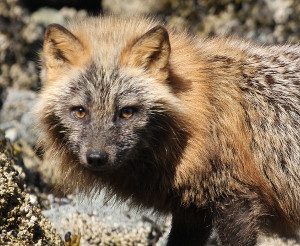

 Share This Page
Share This Page| Home | | Sailing | | Alaska 2012 | |  |  |  Share This Page Share This Page |

Copyright © 2012, P. Lutus. All rights reserved. Message Page
| Prior years: |
Alaska 2002 |
Alaska 2003 |
Alaska 2004 |
Alaska 2005 |
Alaska 2006 Alaska 2007 | Alaska 2008 | Alaska 2009 | Alaska 2010 | Alaska 2011 |
(double-click any word to see its definition)
Figure 1: Micropscope and author on a rainy Alaska day
Figure 2: Microscope image of an unknown
species of salt water algae
This season I decided to carry along my microscope and examine some salt and fresh water samples collected at places I visit. My reason for taking the microscope is that there are sometimes many days of uninterrupted rain between days suitable for hiking or kayaking, and I like to have fun and productive activities even on rainy days.
On hikes in the Alaska countryside, I now carry small plastic sample bottles and collect salt and fresh water from sources that look interesting. Those who have microscope experience will likely agree that "interesting" bodies of water tend to be warm, filled with vegetation and murky — such water tends to teem with life.
Obviously one goal was to take pictures of interesting microscope subjects. I naively thought taking usable pictures through the microscope would be relatively easy, but that was only true for motionless subjects as in Figure 2. Because of my primitive way of linking my camera to the microscope, and because the camera wasn't parfocal with the eyepieces, the many living creatures I saw moved around too fast for successful photography.
Now, while at home, I'm setting up a more useful camera mounting for next season, with the goal that the camera will see what the eyepieces see, in the same focus, and I then would only need to trip the shutter to record what I see through the eyepieces.
But in the meantime, for those who haven't owned a microscope, exploring a drop of water is lots of fun — you're likely to see any number of little creatures swimming around in a drop of pond water. This activity also teaches one to shun anything but pure water for drinking — natural water sources typically teem with little life forms, many of whom would love to get to know you better.
One change I made while in Alaska was to replace the microscope's original light source. The light source built into the microscope in Figure 1 (Omano OM139) is a small, very hot 12V halogen lamp. I wanted to replace it for a number of reasons:
With these goals in mind I looked into my stock of spare parts (of which I have many on my boat) and located a replacement LED light that can be used to upgrade a flashlight from an incandescent to an LED "bulb". This LED light is a fairly common item in hardware stores — it accepts up to a six volt source and is relatively insensitive to supply voltage, so I decided to give it a try.
Replacement was fairly easy — a few minutes with a soldering iron and I had an LED microscope light source. Ironically, the LED replacement light is brighter than the original high-intensity halogen light it replaced, it uses almost no power, and it emits a nearly perfect white light, so the camera can use its "daylight" white-balance setting (example in Figure 2).
I hope the microscope manufacturers are reading this — compared to incandescent lights, LEDs make great microscope illuminators. Years ago, before I cared about the photographic issues, I found it annoying that the microscope illuminator's infrared emission would dry up my water-drop sample spectacularly fast. Now that microscope photography is becoming commonplace, there's another reason to prefer LED illuminators — they can be made to emit a balanced white light, to assure accurate photographic colors.
| Home | | Sailing | | Alaska 2012 | |  |  |  Share This Page Share This Page |